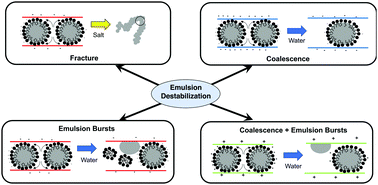Unraveling driving regimes for destabilizing concentrated emulsions within microchannels†
Abstract
Coalescence is the most widely demonstrated mechanism for destabilizing emulsion droplets in microfluidic chambers. However, we find that depending on the channel wall surface functionalization, surface zeta potential, type of surfactant, characteristics of the oil as a dispersed phase, or even the presence of externally-induced stress, other different destabilization mechanisms can occur in subtle ways. In general, we observe four regimes leading to destabilization of concentrated emulsions: (i) coalescence, (ii) emulsion bursts, (iii) a combination of the two first mechanisms, attributed to the simultaneous occurrence of coalescence and emulsion bursts; and (iv) compaction of the droplet network that eventually destabilizes to fracture-like behavior. We correlate various physico-chemical properties (zeta potential, contact angle, interfacial tension) to understand their respective influence on the destabilization mechanisms. This work provides insights into possible ways to control or inflict emulsion droplet destabilization for different applications.



 Please wait while we load your content...
Please wait while we load your content...